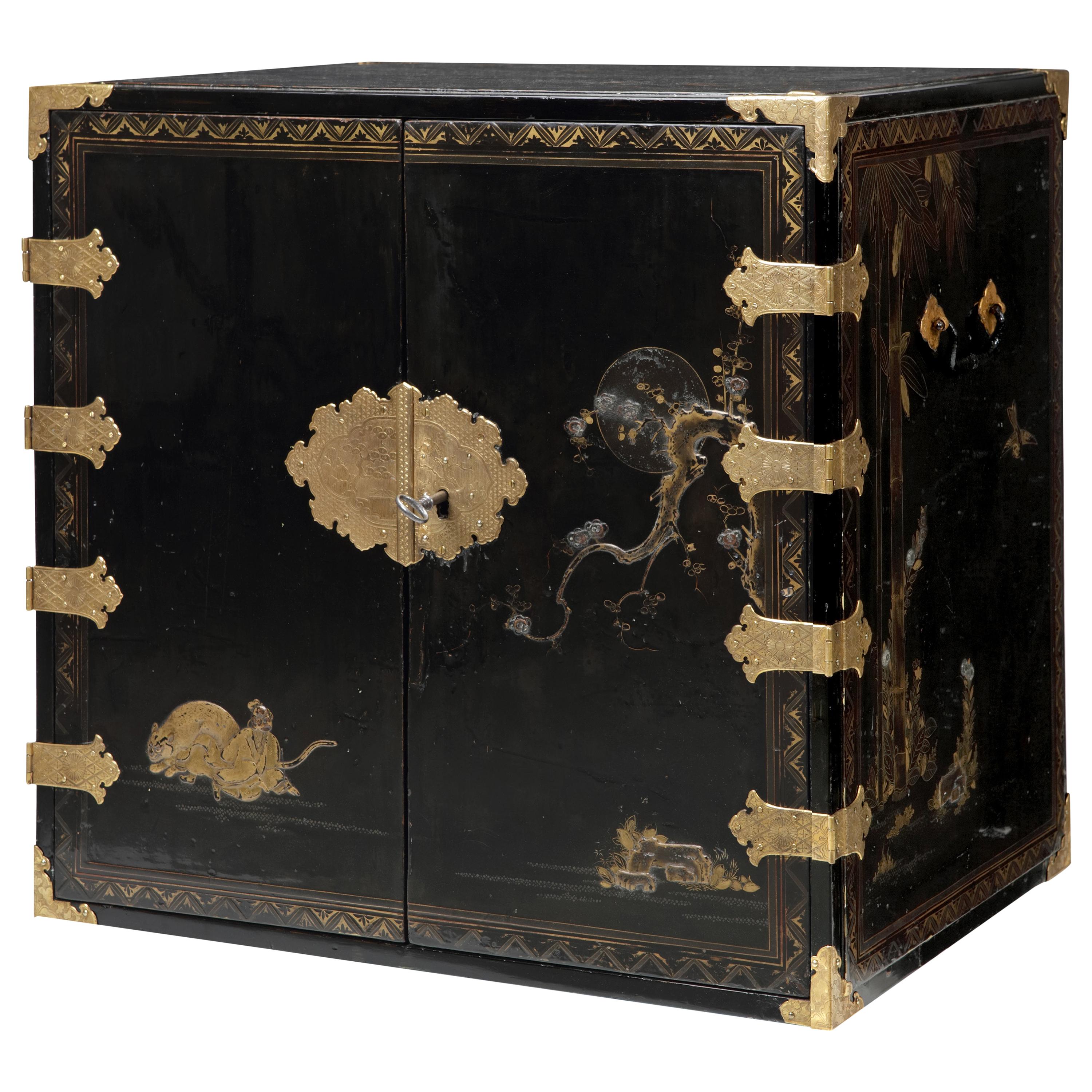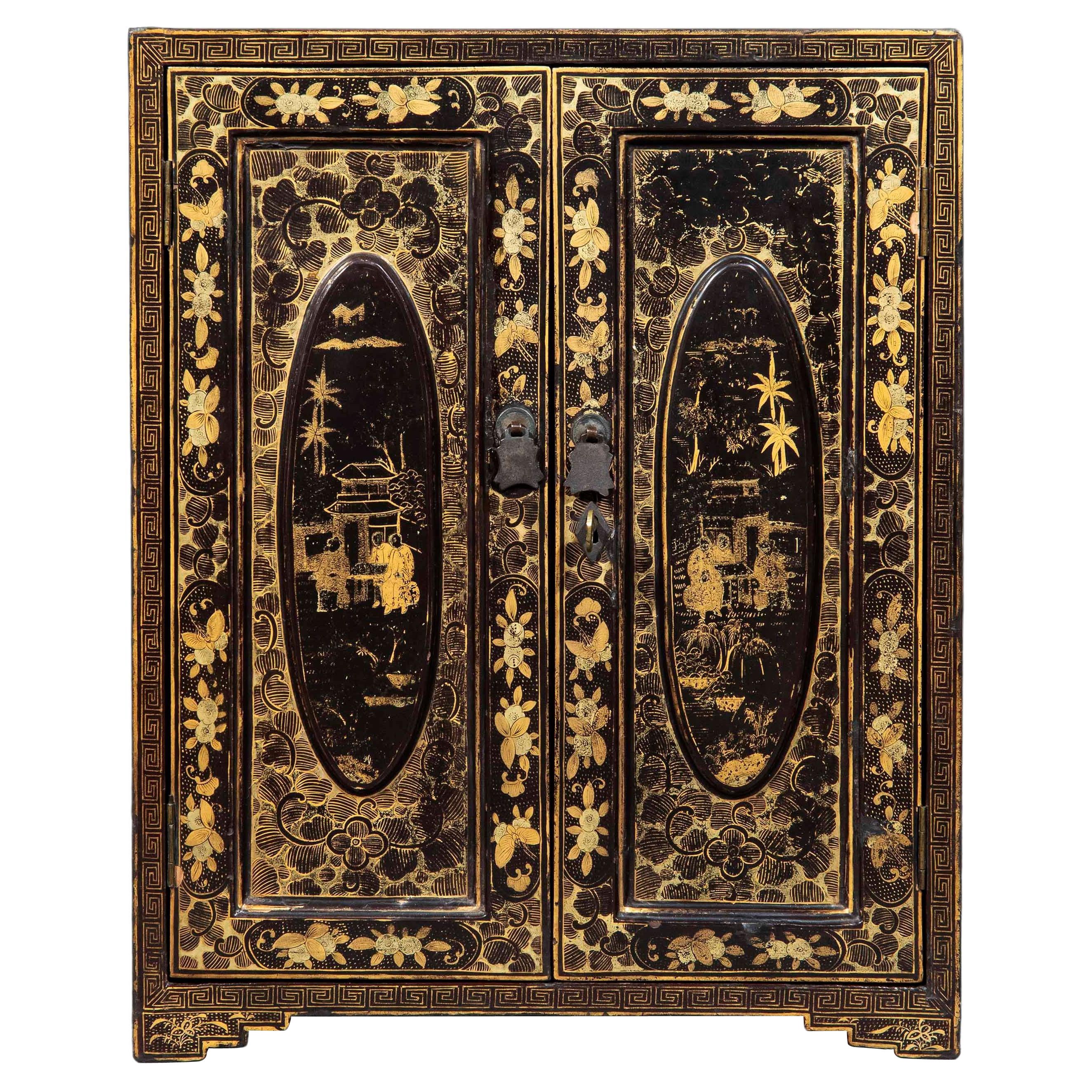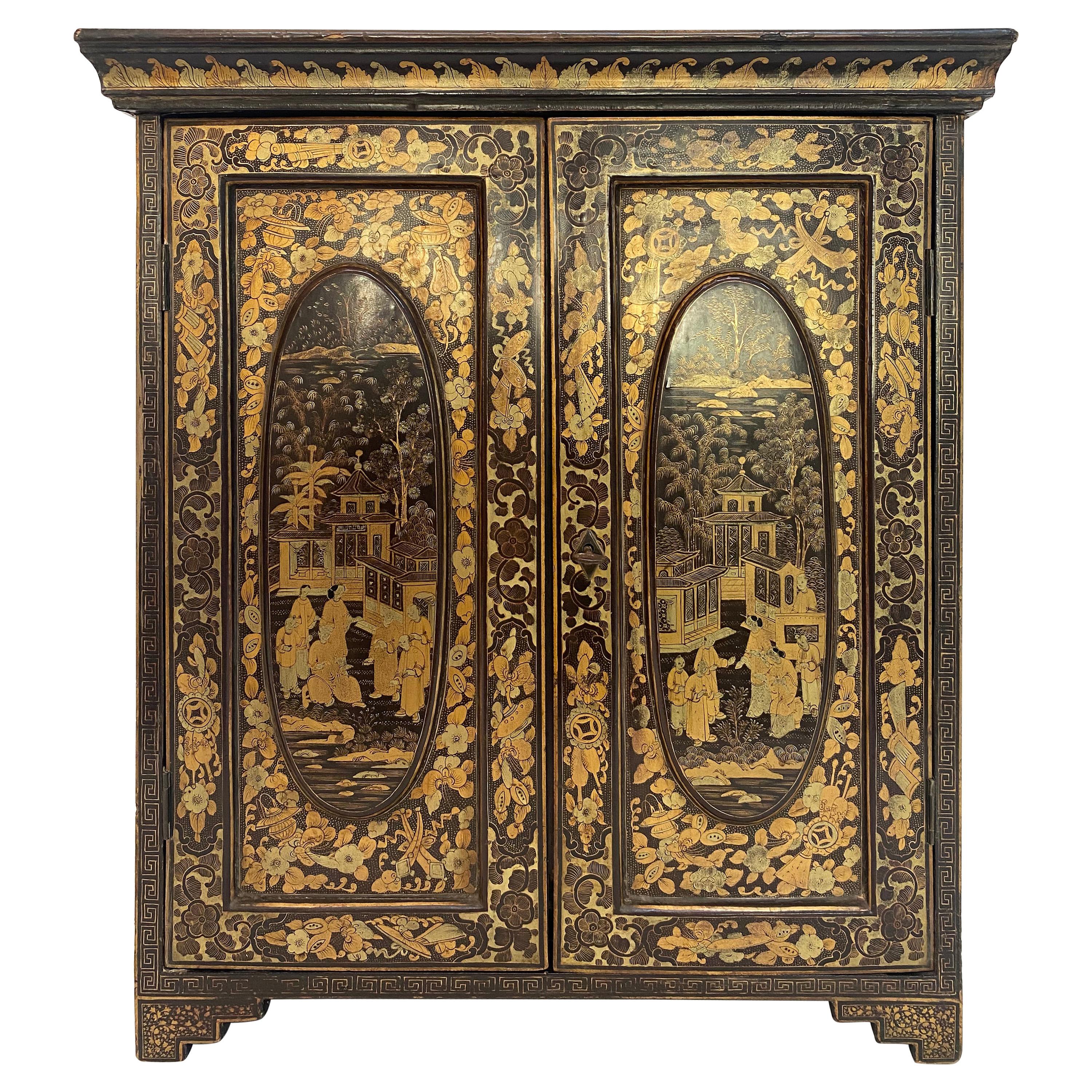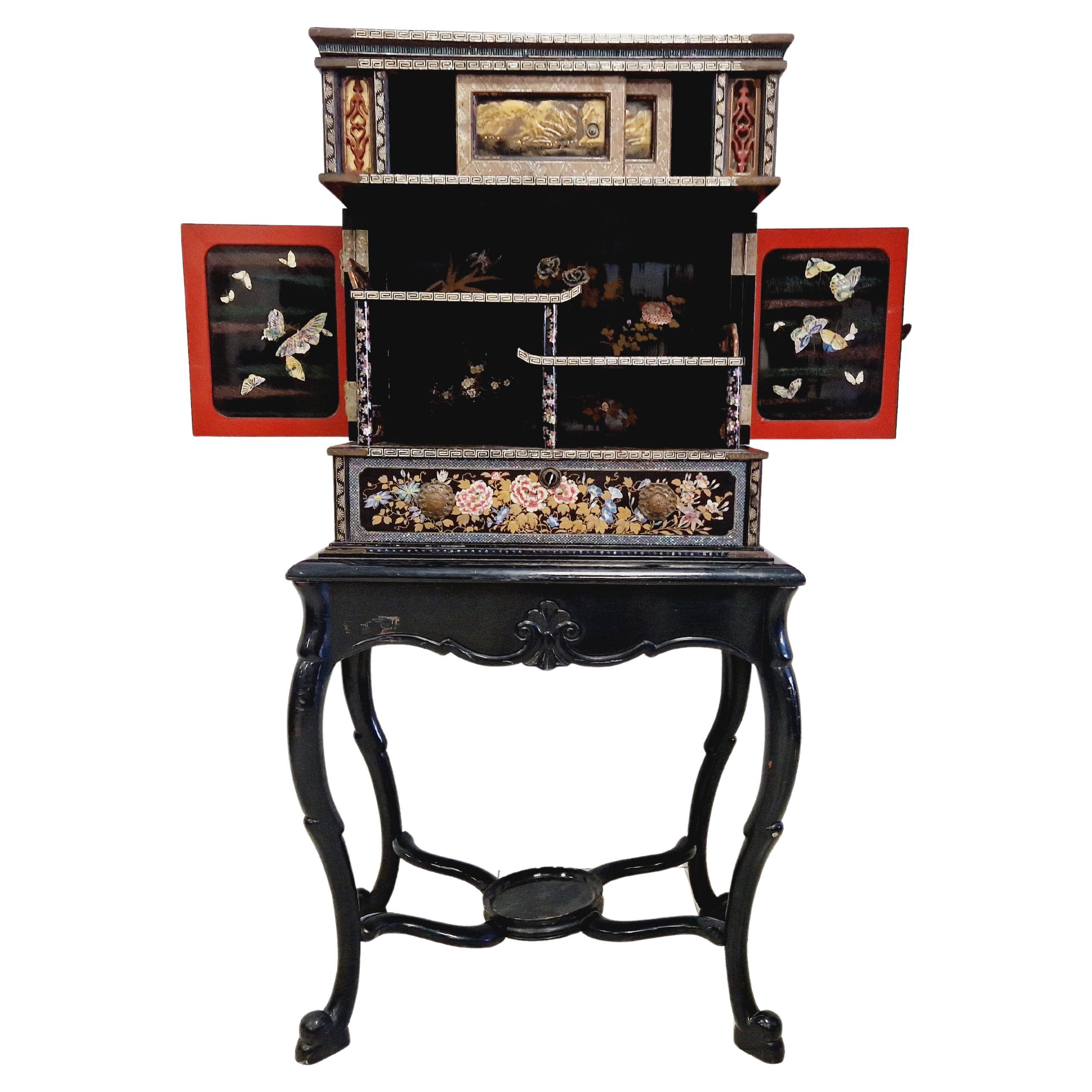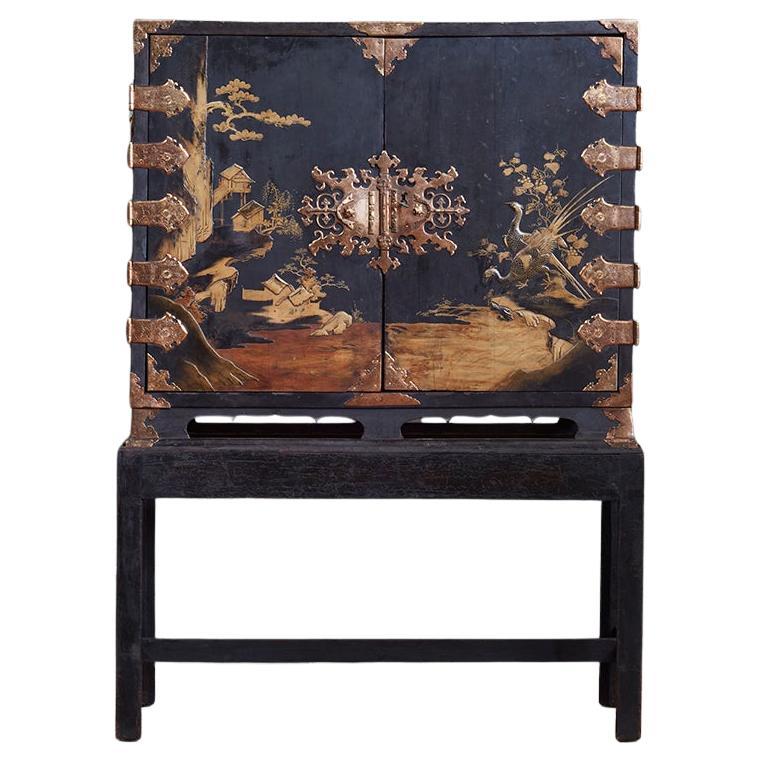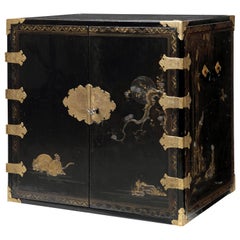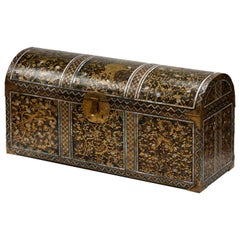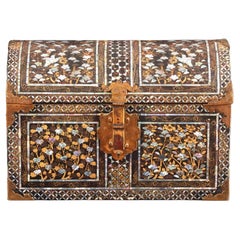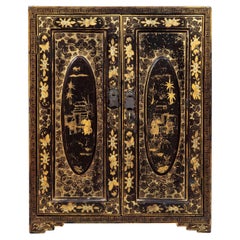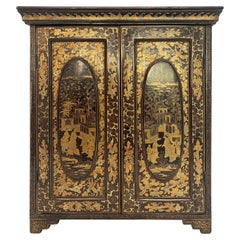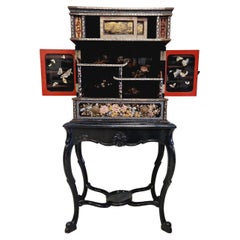Items Similar to Portuguese-colonial Japanese Namban lacquer Vargueno Cabinet, circa 1600
Want more images or videos?
Request additional images or videos from the seller
1 of 3
Portuguese-colonial Japanese Namban lacquer Vargueno Cabinet, circa 1600
$34,500
£26,177.81
€29,931.98
CA$48,187.14
A$53,577.55
CHF 27,975.24
MX$652,169.23
NOK 356,951.88
SEK 334,446.85
DKK 223,387.88
Shipping
Retrieving quote...The 1stDibs Promise:
Authenticity Guarantee,
Money-Back Guarantee,
24-Hour Cancellation
About the Item
A Portuguese-colonial Japanese Namban lacquer vargueno cabinet
Momoyama period, circa 1600
H. 43 x W. 64.5 x D. 36 cm
Wood, black lacquered and decorated with gold and inlays of mother-of-pearl, brass mounts and carrying handles, the fall front lacking. A pictorial-style Namban cabinet, the top decorated in an unusual scene of a tiger attacking deer near a house and garden. Some of the earliest Namban wares produced for the Portuguese were fall-front cabinets or desks, and according to Impey and Jörg although poorly documented, “the Portuguese trade in these objects was clearly extensive” (Impey & Jörg, ibid., p. 124).
Coffer and cabinets, decorated in lacquer, gold and mother-of-pearl, were produced by the Japanese specifically for export to the West. The name Namban was given by the Japanese to Europeans and other 'Southern barbarians'.
These export products developed in response to the Portuguese contact with Japan in the second half of the sixteenth century and were produced until the end of their presence in Japan in 1639 (Oliver Impey & Christiaan Jörg, Japanese export lacquer 1580-1850, Amsterdam, 2005, p. 78). The earliest namban wares are decorated with floral and other motifs in gold, slivers of thin metal and mother-of-pearl inlay set in a mosaic pattern against a black lacquer ground. The designs and techniques that were executed by Kyoto artisans represent a fusion of Chinese, Korean, Japanese and European taste.
- Dimensions:Height: 16.93 in (43 cm)Width: 25.4 in (64.5 cm)Depth: 14.18 in (36 cm)
- Materials and Techniques:
- Place of Origin:
- Period:1600-1609
- Date of Manufacture:Circa 1600
- Condition:Repaired: Probably regarding the age, the cabinet has been re-lacquered in the past. Additions or alterations made to the original: Possibly a fall-front was removed and made into a table top, this is common with such cabinets, since the interior is much more splendid. Wear consistent with age and use.
- Seller Location:Amsterdam, NL
- Reference Number:1stDibs: LU5458231458712
About the Seller
5.0
Recognized Seller
These prestigious sellers are industry leaders and represent the highest echelon for item quality and design.
Established in 1985
1stDibs seller since 2020
23 sales on 1stDibs
Typical response time: 2 hours
- ShippingRetrieving quote...Shipping from: Amsterdam, Netherlands
- Return Policy
Authenticity Guarantee
In the unlikely event there’s an issue with an item’s authenticity, contact us within 1 year for a full refund. DetailsMoney-Back Guarantee
If your item is not as described, is damaged in transit, or does not arrive, contact us within 7 days for a full refund. Details24-Hour Cancellation
You have a 24-hour grace period in which to reconsider your purchase, with no questions asked.Vetted Professional Sellers
Our world-class sellers must adhere to strict standards for service and quality, maintaining the integrity of our listings.Price-Match Guarantee
If you find that a seller listed the same item for a lower price elsewhere, we’ll match it.Trusted Global Delivery
Our best-in-class carrier network provides specialized shipping options worldwide, including custom delivery.More From This Seller
View AllRare Charming 17th Century Japanese Lacquer Cabinet with Gilt-Bronze Mounts
Located in Amsterdam, NL
A fine Japanese pictoral style lacquer cabinet with gilt-metal mounts
Kyoto, Edo period, 1670-1690
Decorated in Japanese relief lacquer work, black lacquer ground decorated...
Category
Antique Late 17th Century Japanese Furniture
Materials
Bronze
$44,969 Sale Price
25% Off
Free Shipping
Large Japanese Namban Lacquer Coffer Arqueta, 16th Century
Located in Amsterdam, NL
A large Japanese Namban lacquer arqueta coffer for the Portuguese market
Kyoto, Momoyama-period, late 16th century
In Hinoki cypress lacquered in ...
Category
Antique 16th Century Japanese Decorative Boxes
Materials
Mother-of-Pearl, Wood
Superb Late 16th Century Signed Colonial Japanese Namban Export Lacquer Coffer
Located in Amsterdam, NL
Superb late 16th century signed colonial Japanese Namban export lacquer coffer
Momoyama period, late 16th/early 17th century, inscribed 'Arisato' on the bottom
H. 30.5 x W. 43...
Category
Antique 16th Century Japanese Lacquer
Materials
Cedar, Lacquer
17th-Century Japanese Namban Lacquer Coffer on French Stand, Possibly by Boulle
By André-Charles Boulle
Located in Amsterdam, NL
An impressive and large Japanese 'Namban' transition-style lacquer coffer with fine gilt copper mounts on a French Re´gence base, possibly by André-Charles Boulle (1642-1732)
Kyoto, 1640-1650, the base 18th century
?The coffer with shaped cartouches on a nashiji ground on the lid, front and sides, with fine decorations in various techniques: takimaki-e (high relief), tsuke-gaki (drawing with narrow lacquer lines and over sprinkling with gold and silver), usuniku-takamei-e (demi relief), kimekomi (pushed inside) and accents of kirigane (small geometrical metal mosaics). Inside the cartouche on the lid a landscape with volcanos...
Category
Antique 17th Century Japanese Lacquer
Materials
Brass, Ormolu
17th Century Japanese Export Lacquer Cabinet with Depiction the Dutch Tradepost
Located in Amsterdam, NL
A highly important Japanese export lacquer cabinet with depiction of the Dutch East India Company tradepost Deshima and the annual Dutch delegation on its way to the Shogun in Edo
Edo period, circa 1660-1680
H. 88 x W. 100.5 x D. 54 cm
This cabinet includes a later European japanned stand, but also a modern powder-coated steel frame.
The latter can be designed and added to your specific needs.
The sides and front of the rectangular two-door cabinet are embellished in gold and silver hiramaki-e and takamaki-e on a black roiro lacquer ground with a continuous design. The two doors depict a long procession of numerous figures travelling on foot and horseback along buildings and a pagoda into a mountainous landscape. This is the annual court journey, Hofreis, of the Dutch from Nagasaki to the Shogun’s court in Edo. Three horseback riders are dressed as Dutch merchants and a fourth figure, probably het Opperhoofd, is seen inside a palanquin, norimon. Just about to cross the bridge, two men are carrying a cabinet like the present one.
Many Japanese figures on either side of the procession are engaged in various activities; some play musical instruments on board of small boats, others are fishing; figures inside buildings are depicted playing go, and farmers are tending to their rice paddocks. The upper part of the right door shows a large mansion, probably the local daimyo’s castle, with men kneeling before a man in the central courtyard.
The court journey fits in with the foreign policy of the shogunate which accorded a role to the VOC alongside China, Korea, and the Ryukyu Islands who also had to pay tribute. However, the VOC employees were traders, having low status in Japan’s social hierarchy, and they were received with less deference than were the state embassies from Korea and the Ryukyu Islands. Nevertheless, the contacts with the Dutch were a welcome source of information to the Shogun about Europe and European science and technology.
The left side of the cabinet depicts, in mirror image, a rare view of the artificial fan-shaped Deshima Island, the trading post for the Dutch in Japan. The island, where the Dutch flag flies, is surrounded by small Japanese boats and an anchored three-masted fluyt (cargo ship), flying Dutch flags, with on the stern the VOC monogram. On the bottom right a busy street of Nagasaki is shown, bordered by shops and leading up to the stone bridge. On the island the trees are beautifully painted, two cows can be seen, and the flagpole, all in very fine detail. Dutchmen and enslaved Malay are visible outside the buildings and two Japanese figures, probably guards, sit in a small hut in the centre.
A maximum of fifteen to twenty Dutchmen lived on the island at any time and soldiers or women were not allowed. Restrictions on Deshima were tight, and the merchants were only allowed to leave the island by special permission. The Opperhoofd had to be replaced every year, and each new Opperhoofd had to make a court journey to pay tribute, present gifts, and to obtain permission to Margaret Barclay eep on trading. In the distance, many birds fly above the hills and a four-story pagoda can be seen. The right side of the cabinet is painted with other horse riders and their retinue journeying through mountains.
The pair of doors to the front open to reveal ten rectangular drawers. The drawers are decorated with scenes of birds in flight and landscapes with trees and plants. The reverse of the left door with two thatched buildings, one with a ladder, underneath a camelia tree with large blooms; the right door with a three-story pagoda nestled among trees and both doors with a flying phoenix, ho-oo bird. The cabinet, with elaborately engraved gilt copper mounts, hinges, lock plates and brass handles, is raised on an 18th-century English japanned wood stand.
A pair of large cabinets...
Category
Antique 17th Century Japanese Edo Lacquer
Materials
Copper, Gold
$1,498,973
Free Shipping
Extremely Fine and Rare 17th-Century Japanese Export Lacquer and Inlaid Cabinet
Located in Amsterdam, NL
An extremely fine and important Japanese lacquer cabinet with gilt-copper mounts for the European market
Edo period, late 17th century
The pictorial style decorated rectangular...
Category
Antique Late 17th Century Japanese Lacquer
Materials
Brass
Price Upon Request
Free Shipping
You May Also Like
19th Century Lacquer Cabinet, Circa 1850
Located in Richmond, London
A striking black lacquer table or jewellery cabinet, exquisitely decorated with Oriental figures and pagodas throughout. Mid-19th century. A highly desirable and sought after model.
...
Category
Antique 19th Century Asian Chinoiserie Lacquer
Materials
Lacquer
19th Century Antique Hand Painted Chinese Lacquer Table Jewelry Cabinet
By The Lacquer Company
Located in Brea, CA
19th century antique hand painted Chinese lacquer jewelry cabinet with a pair of raised panel doors opening to five drawers with turned ivory...
Category
Antique Late 19th Century Chinese Qing Lacquer
Materials
Lacquer
Antique Asian Lacquered and Inlayed Cabinet
Located in Buxton, GB
This antique Japanese lacquered cabinet is a beautiful piece of furniture that is perfect for any collector of antique furniture. The ...
Category
Antique 19th Century Italian Japonisme Furniture
Materials
Shell, Wood
A Mid Eighteenth Century Japanese Lacquer Cabinet
Located in London, GB
Using Japanese “Urushi” lacquer in a beautifully untouched and sleepy condition, on later stand, This Japanese lacquer cabinet on the stand has...
Category
Antique Mid-18th Century Japanese Edo Cabinets
Materials
Wood, Lacquer
Chinese Lacquered Medecinchest, Second Quarter of the 19th Century
Located in Kastrup, DK
A Chinese lacquered apothecary, circa 1820-1840.
77 drawers each with Chinese script for, herbs, minerals and natural remedies.
Original restored lacquer with a wonderful warm color...
Category
Antique 1830s Chinese Qing Apothecary Cabinets
Materials
Elm
Important Early Edo Period 17th Century Miniature Japanese Lacquer Cabinet
Located in Oxfordshire, United Kingdom
A Rare and Important 17th Century Miniature Japanese Lacquer Cabinet, 19 cm H, 17cm W, 16.5cm D.
The exquisitely decorated cabinet depicts fine floral raised scenes to each side. l...
Category
Antique 17th Century Decorative Boxes
Materials
Lacquer
More Ways To Browse
Southern Colonial
Japanese Lacquer Cabinets
Asian Cabinet Black
Antique Japanese Lacquer Cabinet
Japanese Wood Desk
Japanese Tiger
Antique Japanese Desk
Antique Asian Mother Of Pearl Furniture
Japanese Metal Cabinet
Japanese Wood Inlay
Antique Chinese Mother Of Pearl Furniture
Asian Style Desk
European China Cabinet
Portuguese Antique Cabinet
Mother Of Pearl Desk
Antique Colonial Desk
Black Lacquer Japan Cabinet
Black Lacquer Mother Of Pearl Inlay Furniture
